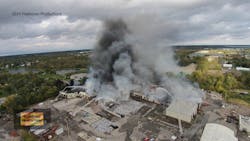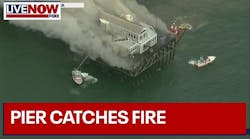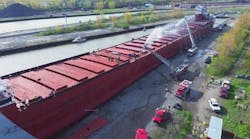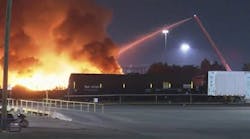On Tuesday, Oct. 7, 2014, a four-alarm fire destroyed seven inter-connected buildings at the Otis Wright industrial complex in Lima, OH. Water supply was a concern, as there were no hydrants close to the scene and the hydrants that were used had low water flows.
Within the structures there were no intact fire walls or a working sprinkler system. The buildings contained tons of plastic, vehicles, rubber, propane tanks and other highly flammable materials, creating an extreme fire load.
The seven buildings were of Type II (non-combustible) and Type III (ordinary) construction. They were built between the 1890s and 2001. Roof structures varied among the buildings, consisting of metal truss, bowstring truss and wooden rafters. All of the buildings had metal roof coverings. The buildings occupied a total of 200,000 square feet. Some of the buildings contained a dry pipe sprinkler system, but it had been inoperative for some time prior to the fire. The buildings were used as a rubber and plastic recycling plant and warehouse.
The Lima Fire Department was dispatched to a reported structure fire at the Otis Wright complex at 707 East Wayne St. at 1:19 P.M. Engines 1, 2 and 3, all 1,500-gpm pumpers; Ladder 1, a 100-foot aerial platform with a 2,250-gpm pump; Heavy Rescue 1; Medic 3; and Command Car 12 responded with 16 firefighters under the command of Battalion Chief Greg Kirkendall.
Initial operations
On arrival, Kirkendall found heavy smoke showing from a warehouse with fire in the northeast corner. Engine 1 and Ladder 1 were positioned at the northeast (B/C) corner of the complex. No interior attack was made due to the heavy fire volume. Engine 1 set up a 500-gpm ram nozzle at the B/C corner and operated through a loading dock door using booster tank water. Engine 1 also supplied a ground monitor with a five-inch line. Engines 2 and 3 laid a 1,500-foot, five-inch line from a hydrant at Wayne and Park streets to Ladder 1.
Once Ladder 1’s aerial master streams were placed into operation, there was not enough water flow to keep the two master streams supplied by Engine 1 in operation. Firefighters hand laid a 700-foot, five-inch line from a hydrant on North Street up an abandoned alley to Engine 1.
Life-safety issues
Firefighters were faced with several life-safety issues during the incident. Initially employees were attempting to remove vehicles and contents that were in close proximity to the fire. Multiple high-voltage transformers and power lines were being impinged upon by the fire, which posed hazards along the entire east side of building and most of its west side.
Structural collapses occurred early in the original fire building and subsequent buildings as the fire progressed. This required moving personnel and equipment out of the collapse zone multiple times. Thunderstorms with high winds and lightning were present in the area. Multiple vehicles, propane-operated forklifts and propane tanks were in the buildings and resulted in several large explosions. Firefighters ordered all employees out of the fire building and attached buildings in the immediate area. No interior attack was initiated. Firefighters operated from doorways initially and then were moved out of the collapse zones.
Kirkendall requested a third alarm at 1:24 P.M. Lima Engine 6, a 1,250-gpm pumper, responded along with Lima Fire Chief Mark Heffner, Fire Investigator Toby Jenkins and Fire Inspector Chris Jackson. Mutual aid was also requested at this time. Responding to the scene were: American Township Fire Department Ladder 1931, a 75-foot quint with a 2,000-gpm pump, Engine 1911, a 1,500-gpm pumper, and Chief Tom Hadding; Bath Township Fire Department Tanker 1303, a 2,000-gpm pumper and Chief Joseph Kitchen; and Shawnee Township Fire Department Ladder 5, a 105-foot aerial platform with a 2,000-gpm pump. Perry Township Fire Department was requested to respond to Lima Central Fire Station to provide coverage for the rest of the city. Perry Township Ladder 7, a 102-foot aerial platform with a 1,500-gpm pump, and Engine 6, a 1,250-gpm pumper, responded.
Exposure protection
Lima Engine 6 was positioned on Pearl Street to protect exposures on the north side of the complex. Firefighters operated two ground monitors. One was supplied by a 200-foot, 2½-inch line and the other was supplied by 350 feet of 2½-inch line. American Township Ladder 1931 was positioned at the northwest (A/B) corner of the building and placed its aerial master stream into operation. This aerial was supplied by a 1,500-foot, five-inch line from a hydrant at Wayne and Pine streets.
Shawnee Township Ladder 5 was positioned on the B (west) side of the building near the midpoint and placed its aerial master stream into operation. The aerial was supplied by the large-diameter line originally laid to American Township Ladder 1931. Firefighters hand laid 500 feet of five-inch line from Lima Engine 6 across the railroad tracks to American Township Ladder 1931 for its new supply line. Bath Township Tanker 1303 assisted with exposure protection along the north side of the complex.
Kirkendall requested a fourth alarm at 2 P.M. Perry Township Ladder 7 responded to the scene and was positioned on the C (north) side of the building. This aerial was supplied by a hydrant in the 400 block of Pearl Street. Its water supply was supplemented by the drafting operation after it was established.
American Township Engine 1911 set up drafting operations at Scoonover Lake. A 1,200-foot, five-inch line was laid from Lima Engine 6 to the lake.
Command staffing
Hadding, the American Township chief, was assigned as the west (B) side operations chief; Lima Deputy Chief Brian Berheide was assigned as east (D) side operations Chief; Bath Township Chief Joe Kitchen was assigned as Logistics officer and Lima Firefighter Jeremy Welker was assigned as accountability officer.
The Allen County Emergency Management Agency (EMA) responded with a mobile command center. Along with the Ohio Environmental Protection Agency Allen County EMA provided air monitoring and water sampling of the Ottawa River that flows along the east side of the complex. Lima/Allen County paramedics responded to the scene with a rehab trailer that was positioned inside the main gate of the facility for firefighter rehabilitation.
With the continued use of four aerial master streams and numerous portable monitors and handlines, Kirkendall declared the fire under control at 6 P.M. Mutual aid units were released at 4 A.M. on Wednesday, Oct. 8. The last Lima units left the scene at 1:30 P.M. on Oct. 9.
Conclusion
Numerous collapses occurred as the fire progressed from north to south throughout the complex of buildings. Fire spread against the wind very rapidly due to the heavy fire load. Defensive operations placed equipment at several locations to cut off the fire, but the fire quickly extended past these points due to void spaces and fire walls that had been breached over the years. Several large explosions also occurred and were believed to have involved propane tanks used for forklifts in the building and a recreational vehicle with two 30-pound propane tanks on it.
Fifty firefighters operated six engines and four aerial apparatus to battle the fire. Four municipal water system hydrants and drafting operations from Schoonover Lake supplied approximately four million gallons of water used to extinguish the fire. Six hundred feet of 2½-inch attack hose and 4,700 feet of five-inch large-diameter supply line were used. Weather conditions were a temperature in the low to mid 60s, cloudy with 10-15 mph winds, scattered thunderstorms and rain showers. Severe thunderstorm warnings and lightning in the area briefly halted aerial operations. One firefighter reported a minor injury at the scene. There were no civilian injuries. Several firefighters reported mild respiratory issues after the fire. The Lima Fire Department was recalled multiple times as the fire continued to smolder under the debris.
The Lima Fire Department investigated the origin and cause of the fire. At this time, the cause of the fire is undetermined. Damage was estimated at $734,000 to the buildings and $400,000 to the contents.
Lessons Learned
The Lima Fire Department conducted an incident post mortem to discuss what went right and what could have been done better. The department believes that incident management training, good working relationships with area fire departments and training in ladder and master stream operations helped to successfully mitigate the incident.
Several of the problems or successes of this incident were:
• Water supply – There were no hydrants close to the scene and the hydrants that were used had low water flows. Three private yard hydrants are located on the property, but were unserviceable due to being in collapse zones or having threads that were incompatible with fire department equipment. Public hydrants that were used required shutting down a major street and cutting a fence to hand lay hose. Additional hydrants necessitated very long lays. Three of the four municipal hydrants provided water flows of 750 gpm or less. The fourth hydrant provided a flow of 1,200 gpm.
• Buildings – There were seven very large interconnected buildings with no intact fire walls or a working sprinkler system. The buildings contained tons of plastic, vehicles, rubber, propane tanks and other highly flammable materials creating an extreme fire load.
• Environmental issues – Water runoff was a concern, as the Ottawa River runs along the east side of the building. The U.S. and Ohio Environmental Protection Agencies did water sampling Tuesday night and throughout the day Wednesday. It was determined that the runoff had little to no impact on the river and that the water quality was very good. Heavy smoke affected residential areas northeast of fire. Air quality was monitored by the Allen County Emergency Agency. There was limited environmental impact from the fire.
• Railroad – The Genesee Wyoming Railroad runs along the north side of the building. Rail traffic was stopped from entering the area as a supply line was laid across the tracks.
• Exposures – Exposed houses on the north side of the building suffered no damage. Several detached buildings on the fireground were saved.
• Additional resources – Call for resources early. From the time of the alarm until the entire 200,000 square feet of warehouse was fully involved was approximately 30 minutes. When faced with a large building or geographical area, assigning operations chiefs to different sides of the structure reduces the span of control on the incident commander and increases safety. Also, use other agencies. County emergency management agencies provide a great resource for logistical items such as fuel, lighting, food and water as well as updated weather information. They also have established working relationships with state and local environmental protection agencies, environmental contractors, etc.
• Accountability – On the fireground, working with four additional departments was a challenge. Assigning an accountability officer made this more manageable, but since this was such a dynamic event covering such a large area, it was still difficult.
—Jay K. Bradish
LIMA FIRE DEPARTMENT
Chief: Mark Heffner
Personnel: 70 career firefighters
Stations: 3
Apparatus: 3 pumpers, 1 aerial platform, 1 heavy rescue, 1 command vehicle, 3 ALS units, 1 reserve quint, 1 reserve engine
Population: 38,000
Area: 13 square miles






